|
|
|
Sort Order |
|
|
|
Items / Page
|
|
|
|
|
|
|
| Srl | Item |
| 1 |
ID:
150831
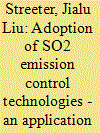

|
|
|
|
|
| Summary/Abstract |
Using data on coal-fired electric power plants, this article investigates the contributing factors affecting the investment decisions on flue-gas desulfurization (FGD), a capital-intensive emission control technology. The paper makes two contributions to the literature. First, the public regulatory status of electric power plants is found to have a strong influence on whether FGD investment is made. Compared to deregulated power plants, those that are still under rate-of-return regulations by Public Utility Commissions are more likely to install FGD. Second, a higher rate of inspections of polluting facilities (not just electric utility power plants) in a state in the previous year is associated with a higher probability of power plants adopting FGD this year. In addition, sulfur content of coal and plant size are both positively associated with the likelihood of FGD installation. The service length of boilers is negatively associated with the likelihood.
|
|
|
|
|
|
|
|
|
|
|
|
|
|
|
|
| 2 |
ID:
086994
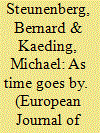

|
|
|
|
|
| Publication |
2009.
|
| Summary/Abstract |
The aim of this article is to explain the speed with which Member States transpose EC directives in the maritime sector. By discussing earlier work, the focus is on explanatory factors related to the contents of the directive that needs to be transposed and the context within which national transposition takes place. The authors' expectations have been tested using data across seven Member States and 32 maritime directives. Using survival analysis based on Cox regression, several political-administrative and legal factors are identified that have an impact on the speed of transposition. The political sensitivity of the directive and the total number of national implementing measures lengthens the duration of transposition, while the degree of specialisation of the directive, the use of package law and experience speed up transposition. The authors also find that the impact of some of these explanatory factors changes over time. This underscores the importance of taking time seriously and to explore time dependency in further theoretical work on explaining policy-making processes.
|
|
|
|
|
|
|
|
|
|
|
|
|
|
|
|
| 3 |
ID:
172196
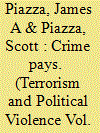

|
|
|
|
|
| Summary/Abstract |
What impact does engagement in crime have on terrorist group survival? In theory criminal activity may decrease group survival by damaging group legitimacy or prompting government crackdowns. Conversely, crime might boost group survival by facilitating access to revenues or by further taxing state policing capacity. Moreover, different types of crime might have different effects. We investigate the impact of crime on terrorist group survival using cross-sectional data on 578 terrorist groups observed between 1970 and 2007. We find that engagement in crime reduces a group’s chance of demise by around 50% and extends its lifespan by around 7 years on average. Terrorist groups involved in narcotics are less likely to end by police or military force, but are also less likely to win political concessions. We find that groups involved in extortion live the longest and are also less likely to end by force or by splintering.
|
|
|
|
|
|
|
|
|
|
|
|
|
|
|
|
| 4 |
ID:
117054
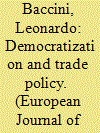

|
|
|
|
|
| Publication |
2012.
|
| Summary/Abstract |
I show that the process of democratization in developing countries constitutes an important factor in the formation of preferential trade agreements. Specifically, democratizing developing countries are more likely to form a preferential trade agreement with richer countries, whereas there is little evidence that democratic transition affects the probability of a developing country joining a preferential trade agreement with other developing countries. This result follows naturally from median voter preferences and the Heckscher-Ohlin and Stolper-Samuelson theorems. Put simply, the median voter gains from trading with the richer states and loses from trading with the other poor states. Since preferential trade agreements allow countries to waive the most-favored nation principle, the need for both trade openness and protectionism against competitors might explain why preferential trade agreements constitute one of the main features of the current wave of globalization. I quantitatively test this hypothesis using a newly compiled dataset that covers 135 developing countries from 1990 to 2007. An important implication of this article is that it could be more challenging than expected to combine domestic political equality with international economic equality.
|
|
|
|
|
|
|
|
|
|
|
|
|
|
|
|
| 5 |
ID:
192708
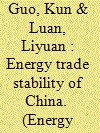

|
|
|
|
|
| Summary/Abstract |
As the world's largest importer of energy, China has been facing severe energy security issues. In the context of the challenges of global energy transformation brought about by climate change and the intensification of global political risks, a survival analysis approach is used in this paper to investigate China's energy trade stability. The results show that the energy trade linkages between China and 153 other countries are complex and unstable, featuring short periods of trade with many countries. Specifically, geopolitical riskier areas, such as the Middle East and Africa, have the lowest trade stability. The survival curves also demonstrate clear heterogeneity among different types of energy. Climate risks, including both physical and transitional risks, are found to have significant effects on energy trade stability. Finally, several policy options are proposed to improve energy trade stability in China, paying special attention to the increasing globe climate risks.
|
|
|
|
|
|
|
|
|
|
|
|
|
|
|
|
| 6 |
ID:
093842
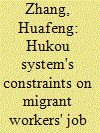

|
|
|
|
|
| Publication |
2010.
|
| Summary/Abstract |
Most studies on discrimination against migrants in Chinese cities focus on wage differentials. This paper endeavours to develop an alternative way of explaining the institutional discrimination against migrants by studying workers' job mobility rates in three cities: Beijing, WuXi and Zhuhai. Migrants are commonly perceived to have high occupational mobility; however, Cox proportional hazards regressions in this paper show a different picture. Institutional discrimination reduces the number of jobs available to the migrants, increases their job search costs and the cost of losing jobs. Even though migrants take jobs unacceptable to local residents, the effects of this institutional discrimination still constrain migrants in changing jobs. The regressions show that temporary migrants have longer job durations and shorter unemployment durations than local people or permanent migrants. Moreover, migrants start to change jobs more often only after they have stayed in the city for some time and have accumulated enough assets to be able to survive when unemployed.
|
|
|
|
|
|
|
|
|
|
|
|
|
|
|
|
| 7 |
ID:
169155
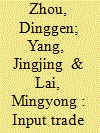

|
|
|
|
|
| Summary/Abstract |
This paper introduces a quasi‐natural experimental framework into trade policy evaluation and reassesses China's trade liberalization through the survival of export products. We use propensity score matching and China's dual trade system to design a quasi‐natural experiment based on Chinese industrial enterprises, customs import and export, and tariff data over the period of 2000–2006; we then use survival analysis to study the impacts of China's trade liberalization on the export duration of manufacturing firms’ products. We find that the substantial reduction in import tariffs after China's accession to the World Trade Organization enhances the export duration of firm products, indicating that trade liberalization ameliorates the survival of export products. The promotion effects of tariff reduction on export duration are obviously stronger for core products than for noncore products.
|
|
|
|
|
|
|
|
|
|
|
|
|
|
|
|
| 8 |
ID:
102084


|
|
|
|
|
| Publication |
2011.
|
| Summary/Abstract |
A well-known finding of research on illegal markets is that drug-dealing organisations operate in risky and uncertain market and intra-organisational conditions that considerably limit their size and their survival time. Yet, little is known about the organisations or individual dealers who are more successful than others at avoiding arrest and incarceration, especially in regard to dealers operating in groups of various sizes. This article proposes to fill this gap in the literature by fitting a Cox proportional hazard model to 'time to failure' data in a sample of 112 incarcerated male inmates who were active as drug dealers in the 3 years preceding their incarceration. The results show that organisational size is unrelated to survival. Instead, the size of dealers' core criminal networks emerged as a key factor in increasing survival in the drug trade. Other results indicate that involvement in markets for certain drugs (cocaine) is more risky than others (cannabis) and that hard drug users are arrested faster than others.
|
|
|
|
|
|
|
|
|
|
|
|
|
|
|
|
| 9 |
ID:
188159


|
|
|
|
|
| Summary/Abstract |
This paper analyses the life-cycle dynamics of zombie companies – broadly defined as businesses that are consistently unable to meet their interest expenses from current profits – amongst listed firms in China over the period 2008–2019. A large share of zombie companies subsequently return to nonzombie status. This proportion is higher for firms undergoing a major restructuring event, low leverage levels, and with smaller operating expense ratios. However, zombie firms that return to nonzombie status continue to have lower levels of profitability compared with their industry peers and have a higher probability of relapsing into zombie status compared with firms that have never been classified as zombie. Concerted efforts to revive zombie companies using major restructuring events appear insufficient in overcoming the longer term scarring effects of zombification on firms' profitability. The results highlight the potential benefits of the ongoing efforts by Chinese regulators to improve the delisting process.
|
|
|
|
|
|
|
|
|
|
|
|
|
|
|
|
| 10 |
ID:
185489
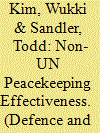

|
|
|
|
|
| Summary/Abstract |
This paper examines the effectiveness of non-UN-led peacekeeping operations (PKOs) from two alternative perspectives. First, the four kinds of regional and international (out of region) PKOs are investigated based on their ability to curtail one-sided violence (OSV) against civilians by host governments or rebels. That analysis is further bolstered by propensity-score matching to ameliorate potential selection bias stemming from non-UN PKOs. For the matched sample, we find that non-UN peacebuilding and peace enforcement missions limit rebel caused OSV, which is a novel result. Second, the ability of non-UN PKOs’ troops and police to end conflict or to maintain peace are ascertained based on survival analysis. Non-UN troops, but not police, curtail the transition from peace, regardless of matching. Generally, non-UN PKOs display effectiveness in limiting OSV or maintaining peace, but not in ending conflict.
|
|
|
|
|
|
|
|
|
|
|
|
|
|
|
|
| 11 |
ID:
094737
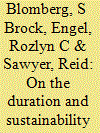

|
|
|
|
|
| Publication |
2010.
|
| Summary/Abstract |
This article aims to improve scholars' understanding of how transnational terrorist organizations emerge, survive, thrive, and eventually die.The authors use a data set that catalogues terrorist organizations and their attacks over time (the ITERATE database of thousands of terrorist events from 1968 through 2007) and merge those data with socioeconomic information about the environment in which each attack occurs. They use these data to trace the life cycle pattern of terrorist activity and the organizations that perpetrate them. They identify at least two types of terrorist organizations- recidivists and one-hit wonders. The authors find that recidivist organizations, those that have repeatedly attacked, are less likely to survive once political and socioeconomic factors have been included. However, they find that sporadic or one-hit wonders are not easily deterred by socioeconomic factors, leaving open a role for counterinsurgency tactics.
|
|
|
|
|
|
|
|
|
|
|
|
|
|
|
|
| 12 |
ID:
159050
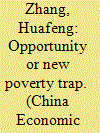

|
|
|
|
|
| Summary/Abstract |
Despite its rapid economic growth, China has never managed to reduce its rural-urban divide with its reforms and marketization of the economy. The huge gap between urban and rural education is embedded in the disparity in educational investment, children's educational attainment, school quality and the returns to education. Migrant children move with their parents to urban cities to pursue a better education. However, the Chinese household registration system (hukou system) limits migrant children's rights and access to basic education in the cities. Will migrant children benefit from a better-quality education in the cities, or will they continue to be constrained by their hukou registration? Will the large-scale internal rural-urban migration provide the opportunity to reduce rural-urban education inequality in China, or will it merely create a new education-poverty trap? Based on publicly available large-scale survey data (RUMiC), this paper applies logistic regression and survival analysis to illustrate the new education-poverty trap imposed on migrant children by the institutional constraints and hierarchies in children's education, created by the Chinese household registration system in Chinese cities.
|
|
|
|
|
|
|
|
|
|
|
|
|
|
|
|
|
|
|
|
|